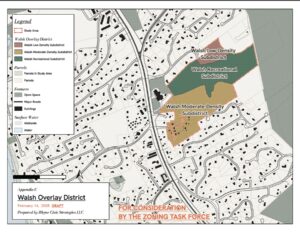TRURO — The town’s ad hoc Zoning Task Force has drafted a proposal to create a so-called overlay district that would modify current rules for residential zoning within the town’s existing water protection overlay district. The changes are needed, members of the task force and outside experts say, for forward movement on development at the 70-acre Walsh property that the town bought in 2019.

Their proposal will be presented to the select board on Feb. 25 to see if the board will put it on the May town meeting warrant.
The task force arrived at its final draft at a Feb. 18 meeting after several sessions this month and last, including two with the Walsh property advisory committee, and after several rounds of revisions. Kennan Rhyne, a Boston-based urban planner and architect working as a consultant, was the task force’s planning expert on the proposal.
The task force’s aim was to introduce zoning flexibility while preserving Truro’s character, task force chair David Bannard told the Independent. “Truro is a rural town, and we don’t want that to be interrupted,” he said. The groundwork has been intense but worth it, Bannard said, because “we wanted to bring something to town meeting that we’ve really been able to think through.”
Town Planner Barbara Carboni said that Truro took inspiration from Eastham, where a zoning task force has introduced 17 proposals at the last three town meetings to further the town’s village center vision. This task force’s work is a response to recommendations in both the Walsh Advisory Plan and Truro’s 2023 Local Comprehensive Plan, which suggested that the town needed to evaluate its zoning and general bylaws to identify opportunities for increased housing production and economic development.
“The task force has listened to a lot of our recommendations, and they have changed a lot of things in response to what we were concerned about,” said Walsh committee chair Jeffrey Fischer.
The Walsh Advisory Plan, whose 18 recommendations were approved at last year’s town meeting, outlined a vision for the property, but Truro’s existing zoning bylaws would hinder its implementation. That’s because, as they stand, the town’s zoning would restrict construction on the property to single-family homes, duplexes, and auxiliary dwelling units.
The current bylaws are inconsistent with the vision of denser clusters of apartments built around shared outdoor common spaces and include water protections that ignore plans for on-site wastewater management.
The overlay district proposed in Truro creates three subdistricts with specific development guidelines for the Walsh property.
A low-density area focuses on compact, affordable housing with smaller lots clustered around shared community spaces. A moderate-density area allows mixed-use development and multifamily housing, aiming for walkability and compatible commercial uses. The third subdistrict, a recreation area, preserves open space.
Carboni said that the proposed uses fall into two categories as far as permitting goes. Some are “as-of-right,” so would not require additional permits; others are special-permit uses, which would need further review. If a use is not specified in the overlay district proposal, the underlying zoning regulations would remain in place.
Critics of the town’s development plans for affordable housing at the Walsh property have said that the overlay proposal amounts to “spot zoning.”
State law prohibits spot zoning, which occurs when a single small lot is given special zoning treatment, different from that of surrounding land, solely for the owner’s economic benefit. The Walsh property’s large size and diverse development scope mean that it does not meet that definition, Bannard said.
“Current zoning is never going to get us to a point of solving the housing crisis,” said Laura Shufelt, an affordable housing expert with the Mass. Housing Partnership. “Freeing up zoning is step one. As long as we have one- and two-acre single-family homes, there’s going to be an affordability issue.”
The overlay approach allows the town more control than it would have in the case of a Chapter 40B affordable housing project, which would grant a developer broad exemptions from local zoning bylaws, both Bannard and Carboni said.
“40-B is a useful tool, but it gives the developer the control over what’s built,” said Bannard. “The town really has less of a say in how things are built and what they look like on the property.”
Some zoning overlay districts, including the ones for Truro, “allow greater flexibility for the developer with a level of control over design and other dimensional things for the town,” said Shufelt.
The proposal specifies dimensional requirements for construction on the Walsh property. Structures in the moderate-density area, located in the interior of the property, may reach three-and-a-half stories, while those near the property’s boundaries are limited to two stories. Each unit must have at least one parking space, with shared and off-site parking options under consideration.
Another key provision in the overlay district proposal is an inclusionary zoning requirement calling for at least 20 percent of the units to be designated as affordable housing for households earning up to 100 percent of area median income, whereas typical 40B projects require 20 to 25 percent of units be affordable for those earning up to 80 percent of that median.
Additionally, all residential housing within the district must be for year-round residency, with short-term rentals prohibited.
Striking a balance between zoning flexibility and practical development incentives is a key challenge, Fischer added. “We don’t want the zoning to be so strict that people aren’t willing to bid on it,” he said. Another concern is that some of the recommendations of the original Walsh property committee were “fuzzy.” For example, Fischer said, it never finalized a specific acreage limit for undeveloped land.
The Walsh committee aims to develop 50 to 80 units in the initial phase. Development for the entire property is capped at 28.5 of the 70 acres.
Several major questions remain, including water availability, wastewater treatment, and potential access points to Route 6. “These three big pieces of infrastructure will affect both where the housing can be located on the property and how many units we can do in the initial phase,” said Fischer.
The town is working with Provincetown and wastewater consultant Scott Horsley on water and wastewater planning. A second traffic study is scheduled for summer because the first study was conducted during winter when traffic is lighter.
After receiving final Walsh committee recommendations — the timeline for them is not yet firm, Fisher said — the town will draft requests for proposals covering water supply, wastewater treatment, road construction, and other infrastructure elements.
The zoning task force will hold a listening session at town hall on Wednesday, Feb. 26 from 5 to 7 p.m. to gather community feedback and answer questions.



